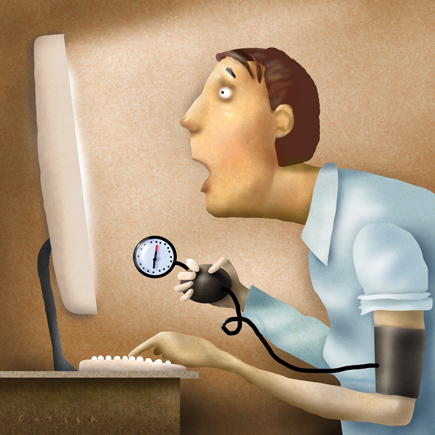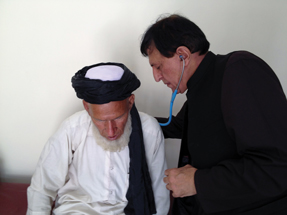Coping skills, counseling best for low back pain
Despite all the best evidence and guidelines, patients with low back pain are still spending time, effort and money on things that aren't helping them in the long run.
Despite myriad guidelines and related evidence, patients coping with low back pain continue to be treated too often with inappropriate imaging tests and opioid medications, according to a recent analysis.
The study, which assessed nearly 24,000 spine-related doctor visits from 1999 through 2010, found that the rate of physical therapy referrals didn't significantly change over time but remained at about 20%. However, opioid use increased from 19.3% to 29.1%, according to the findings, published online by JAMA Internal Medicine in July. The ordering of CT scans or MRIs also increased from 7.2% to 11.3%; X-ray rates remained stable at 17%. Meanwhile, patient referrals to other physicians doubled, from 6.8% to 14%.

“A lot of money is being spent on back care for things that aren't necessarily helping patients in the long run,” said Bruce Landon, MD, FACP, the study's senior author and professor of health care policy and medicine at Harvard Medical School in Boston. Even sending a patient to another doctor can influence subsequent treatment, he said. “The referral is actually initiating a process that will often lead to the delivery of these services that might not be needed.”
The study's findings follow in the wake of various guidelines, including those published by the American College of Physicians in 2007, that recommend relatively little treatment and testing during the first month of back pain, once worrisome causes like cancer or severe, progressive neurological conditions have been ruled out. Early use of imaging tests also has been discouraged by recent initiatives, such as the American Board of Internal Medicine Foundation's Choosing Wisely campaign, which advises against even an X-ray within the first 6 weeks, absent any red flags.
The largely wait-and-see approach Table in the ACP guidelines—involving applying heat, remaining as active as possible, and taking nonsteroidal anti-inflammatory drugs (NSAIDs)—is not always well received by patients coping with pain, said Erika Yamada, MD, assistant professor of medicine at Icahn School of Medicine at New York City's Mount Sinai Hospital.
“If it's the first time that they are having back pain and it's kind of severe, then they are often very scared,” she said.
Dr. Yamada estimated that she refers fewer than 5% of her patients with acute back pain immediately for an imaging test or to another physician specialist. She first walks her patients through a workup, checking for any urgent concerns, before reassuring them that the pain will likely ease or pass.
“You really have to do a lot of managing their expectations,” she said. “That takes a lot of time. It's so much easier to just order the MRI.”
Assessing acuity
For back pain sufferers, more spending on medical care, including surgery, has not paid off in terms of better relief, according to a Journal of the American Medical Association study published in 2008. Researchers surveyed 22,000-plus people nationally, first in 1997 and later in 2005, finding that the average amount spent annually on spine-related care increased from $4,695 to $6,096.
Despite the investment, the percentage of Americans with spine-related issues who reported an impact on their daily functioning also increased during that same time span, from 20.7% to 24.7%.
Another study in Archives of Internal Medicine identified similarly dispiriting results after surveying North Carolina residents in 1992 and again in 2006. The percentage of adults who reported impaired functioning related to chronic back pain, defined as persisting at least 3 months, increased over the 14-year period from 3.9% to 10.2%, according to the findings, published in 2009.
Easing back pain can be frustrating and complex, in part because of its cyclical and multifaceted nature, physicians said. Patients may report discomfort that starts as an acute episode and then morphs into a more chronic problem. Or they may suffer periodic acute flare-ups, for example, by throwing out their back more than once.
As a result, they may develop strong opinions based on personal experience, Dr. Yamada said: “There are some patients who say, ‘I know I need Percocet for this pain.’”
In cases of acute pain, Dr. Yamada starts by asking about any worrisome symptoms, such as difficulty urinating or severe and progressive numbness that extends down the leg, a history of or risk factors for cancer, trauma, and other red flags. If the patient has a fever or admits to being an IV drug user, the possibility of a spinal infection should be evaluated, she said. Those types of symptoms are all reason for an urgent referral, often to the ED, Dr. Yamada said.
But those situations are relatively rare. No more than 5% of patients seeking help from a primary care doctor will have an underlying disorder, such as cancer, a compression fracture or a spinal infection, according to studies cited by the ACP guidelines on low back pain, which were developed with the American Pain Society.
A trickier scenario is when a patient reports sudden and debilitating pain with no signs of an urgent underlying cause, Dr. Yamada said. One example is milder sciatica, which is not an emergency but can be quite uncomfortable and cause understandable worry, she said. “It can feel like an electric shock running down the back of the leg—sharp, shooting pains.”
As Dr. Yamada assesses patients, she tries to gauge their overall mood and coping skills. Mood can become intertwined with pain, particularly as the discomfort becomes more chronic, said William Becker, MD, an assistant professor at Yale School of Medicine in New Haven, Conn., whose research has focused on pain and opioid prescribing.
“Pain is in many cases just one part of the picture that's making their functional status impaired,” he said. “Pain makes depression worse. Depression makes pain worse.”
Once urgent causes are ruled out, Dr. Yamada educates the patient about the underlying mechanism of back pain, including how the muscles and ligaments can become strained or spasm. For that reason, she stresses that it's important to stay as mobile and active as possible, in an effort to loosen up that area.
She also may prescribe muscle relaxants and NSAIDs, along with a measure of time to heal. “I say, ‘I see this very often. Eighty to 90% of the time, you are going to be back to normal within 6 weeks.’”
The less-is-more case
To preserve the doctor-patient relationship, it's key that primary care doctors lay out the rationale for a more restrained approach to back pain relief, Dr. Landon said.
If a patient wants a costly imaging test, explain why it likely won't help and the potential risks it could pose, including radiation exposure, he said. The Choosing Wisely campaign highlights radiation concerns even with X-rays, noting that radiography of the back delivers 75 times as much radiation as a chest X-ray.
ACP guidelines recommend against routine imaging for nonspecific low back pain that has recently developed, stating that “... there is no compelling evidence that routine imaging affects treatment decisions or improves outcomes.” Imaging might be considered if the patient is a potential candidate for surgery, such as for spinal stenosis, the authors wrote.
Along with explaining the lack of benefit, doctors should describe the “downstream consequences of doing that imaging,” Dr. Landon said. The scans, particularly with older individuals, might reveal some type of abnormality. “These abnormalities get seen and then somebody wants to do something about that,” he said. “So the imaging itself is something that leads to further procedures, such as injections or surgery.”
In the course of prescribing opioid medications, doctors also should set limits early on, Dr. Becker said. In cases where a patient has already tried high doses of over-the-counter NSAIDs and still can't get out of bed, a short course of a low-dose opioid “is reasonable,” he said.
But the patient should be educated that if the pain persists beyond several weeks, “we are going to have to take a whole different approach,” likely incorporating physical therapy and addressing any underlying mental health issues, among other measures, Dr. Becker said. “We know that part of the reason why patients sometimes have difficulty coping with chronic pain is related to mood in many cases,” he said.
Once pain appears to be shifting into a more chronic problem, it's important to sit patients down and let them know that there will be no single or simple solution, Dr. Becker said.
A variety of approaches might provide some benefit, among them cognitive behavioral therapy, yoga, physical therapy and relaxation techniques, he said. But the patients can't be passive, Dr. Becker said, stressing that it's important that they choose their own pain relief approach based on their preferences and lifestyle.
He said he tells them, “Let's get out of this mindset of imaging studies and quick fixes and start thinking more about how we're going to help you cope with what's really a chronic disease. Having chronic nonspecific low back pain is really a chronic disease that needs to be managed just like high blood pressure.”
Opposing forces
Doctors who are striving to adhere to back pain guidelines face numerous countervailing forces, said Don Casey, MD, FACP, who authored the JAMA Internal Medicine commentary that reflected on Dr. Landon's findings. He cited, among others, patient pressure for quick answers, the perception of specialists as better experts and the time constraints on doctors, along with a nagging liability fear that they might overlook a more serious medical issue.
In big cities, a patient pushing for a specific pain relief remedy might simply shop around to another practice, said Dr. Casey, who is chief medical officer at NYUPN Clinically Integrated Network, which is associated with NYU Langone Medical Center in New York City.
Roger Chou, MD, FACP, who authored the 2007 ACP guidelines, points out other barriers. Too often, insurance coverage is limited for other types of health care that may be helpful, such as physical therapy or mental health services, he said. Plus, doctors are increasingly rated in part based on patient satisfaction, making them reluctant to let a patient walk out empty-handed and dissatisfied, he said.
But Dr. Chou, who is an associate professor of medicine at Oregon Health & Science University in Portland, also noted some hopeful signs. He cited the imaging cautions in the Choosing Wisely campaign as one example. And some hospital initiatives have shown that significant changes in practice habits can be achieved, said Dr. Chou.
He praised one initiative to limit inappropriate lumbar MRIs that was started in 2005 at Seattle's Virginia Mason Medical Center. It incorporated several elements, including a series of questions that clinicians had to answer to confirm compliance with medical guidelines. Patients also were offered easy access to physical therapy. Once the approach was implemented, the rate of lumbar MRIs declined by 23.4%, according to the retrospective analysis, published in 2011 in the Journal of the American College of Radiology.
While these sorts of discussion require more than a few minutes, Dr. Chou believes that the time factor can be exaggerated. In cases of acute back pain, the patient's workup and related education typically consume no more than 20 to 25 minutes, he said.
Dr. Chou acknowledged that patients can occasionally be “insistent and not logical.” But doctors shouldn't accede to an inappropriate approach, any more than they would if a patient advocated for a blood thinner or argued that inadequate blood pressure control was OK, he said.
“For some reason with pain, there is kind of this idea that it's all up to the patient,” Dr. Chou said. “I think we have to get back to thinking that our job is to provide the best care for the patient, and sometimes that means not ordering things or doing things that patients may request.”





